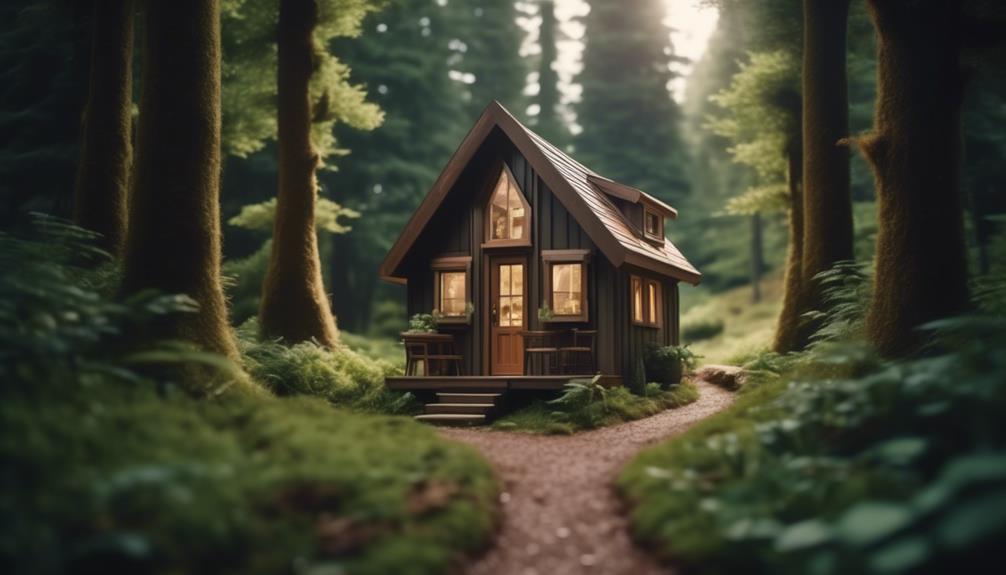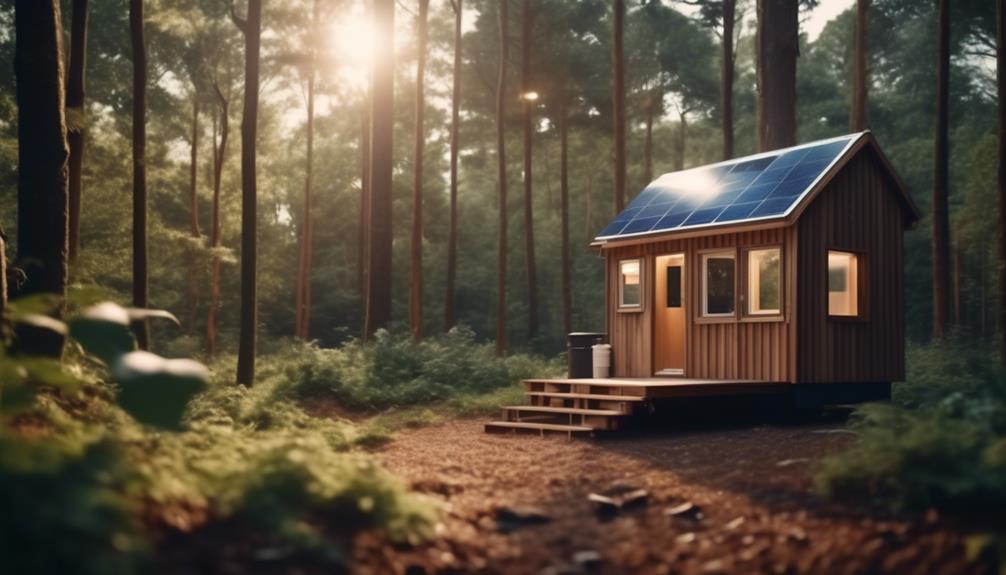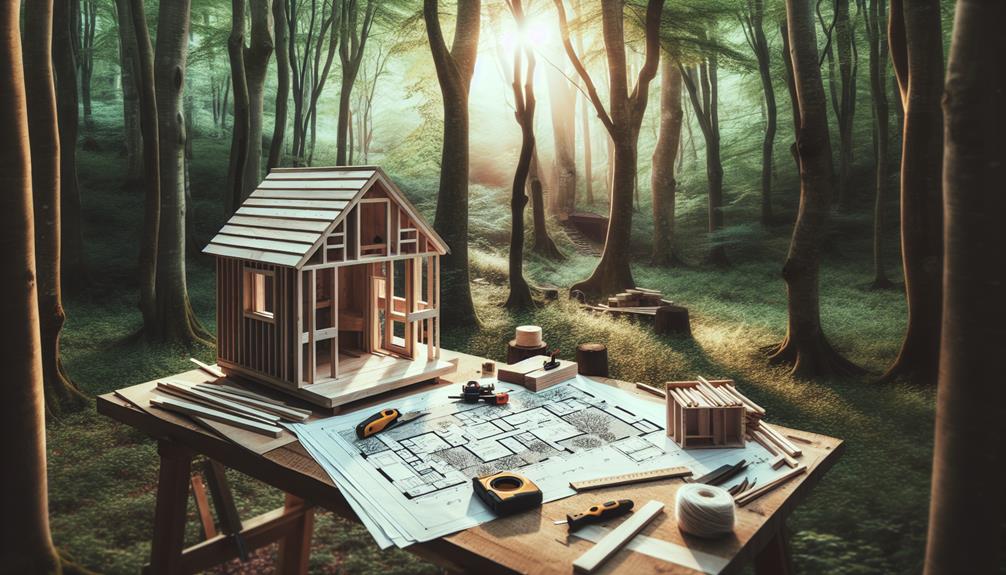While the idyllic vision of a tiny home nestled in a secluded woodland may seem straightforward, you might not be aware of the intricate web of zoning laws that can dictate the feasibility of your dream.
As you consider setting up your own diminutive dwelling among the trees, you'll need to navigate not only the natural landscape but also the complex terrain of building codes and land use regulations.
To avoid any legal pitfalls, you must acquaint yourself with the specific requirements that could significantly shape your build—everything from the minimum square footage to the acceptable distance from water bodies.
Bear in mind that your project's success hinges on more than just an appealing design or a set of blueprints; it's also about understanding the lay of the land in both a literal and regulatory sense.
Will you be prepared to balance your vision with the pragmatic aspects of construction and compliance? Let's explore the crucial considerations that could make or break your tiny home aspirations.
Key Takeaways
- Familiarize yourself with zoning laws and seek professional guidance to ensure compliance with local codes.
- Prioritize sustainable and environmentally-friendly design principles when planning and designing your tiny home.
- Maximize space efficiency by incorporating dual-purpose furniture and adopting a minimalist mindset.
- Choose sustainable materials that minimize environmental impact and ensure durability for your tiny home construction.
Understanding Zoning Laws
Before embarking on the construction of your tiny home in the woods, it's crucial to acquaint yourself with the specific zoning laws that govern your chosen location. These regulations dictate permissible land uses and building requirements. Adhering to these protocols ensures your project aligns with environmental stewardship and innovative design principles.
To avoid costly mistakes, you should seek professional guidance. This guidance may earn a commission, but it can provide invaluable insight into the nuances of local codes. Rigorously vetting your tiny home plans against these standards not only guarantees compliance but also fortifies the sustainability and safety of your woodland retreat.
Stay abreast of any regulatory updates that might impact your build, especially if you opt for a mobile tiny home. Mobile tiny homes must meet specific RV requirements.
Planning Your Tiny Home Design
As you sketch your tiny home's blueprint, ensure it aligns with local zoning and legal constraints to prevent future compliance headaches.
Focus on space efficiency by incorporating multi-functional furniture and vertical storage solutions that optimize your living area.
Select sustainable materials, such as reclaimed wood or bamboo, that reduce your environmental footprint while providing durability and aesthetic appeal.
Zoning and Legal Issues
Navigating zoning and legal requirements is a crucial step in ensuring your tiny home design meets local regulations and sustainability standards. Before you embark on your tiny home build, it's imperative to research and comply with the zoning and legal issues that may affect your project. This technical diligence will not only streamline your building process but also reflect your commitment to eco-friendly practices.
When you choose the right location, consider the zoning laws that govern building a tiny home. Here's an impactful table to guide your understanding:
| Requirement | Emotional Impact | Sustainability Aspect |
|---|---|---|
| Zoning Approval | Security in Legality | Ensures Ecological Alignment |
| Building Codes | Safety and Peace of Mind | Promotes Safe, Durable Structures |
| Land Use Laws | Harmony with Nature | Protects Local Ecosystems |
Understanding and adhering to these regulations is the foundation of a successful and innovative tiny home in the woods.
Maximizing Space Efficiency
Having ensured your tiny home adheres to local zoning and sustainability standards, let's focus on the art of maximizing space efficiency in your design. As you plan to build your own tiny house, every square foot counts. Here's how to ensure you're making the most of your compact space:
- Design for Dual Purpose: Incorporate furniture that doubles as storage and foldable workspaces that tuck away when not in use.
- Strategic Appliance Selection: Choose appliances specifically designed for tiny houses, which offer the same functionality with a smaller footprint.
- Minimalist Mindset: Embrace a clutter-free lifestyle by selecting only the essentials that support your day-to-day living.
Thorough planning and a focus on space-saving innovations will turn your vision of eco-friendly tiny living into a functional reality.
Choosing Sustainable Materials
When planning your tiny home design, selecting sustainable materials is crucial for minimizing environmental impact and ensuring long-term durability. Start by researching materials that fit the unique challenges of your site. Consider metal roofing for its longevity and recyclability; it's an innovative choice that withstands the elements and offers high solar reflectance.
Incorporate salvaged materials into your build—these repurposed pieces not only reduce waste but also add character to your home. Be patient in collecting these items to avoid clutter and maintain organization.
Additionally, integrate solar panels into your design to harness clean energy and reduce reliance on traditional power sources. Prioritize materials that offer both functional efficiency and a reduced carbon footprint.
Securing Building Permits
Before embarking on your tiny home construction, it's essential to secure the necessary building permits by thoroughly checking local regulations and ensuring your plans comply with the area's zoning and building codes. Navigating the nuances of permits can be complex, but it's a critical step in your journey to build a tiny home from scratch that's both innovative and eco-conscious.
- Submit detailed, professional architectural plans that highlight sustainable design features.
- Consult with local authorities to understand the intricacies of tiny home improvement regulations.
- If opting for mobility, follow RV requirements to ensure your tiny home on wheels meets all legal standards.
Securing permits isn't just a bureaucratic hurdle; it's an opportunity to align your home with the latest in eco-friendly innovation.
Considering Access and Location

As you select the location for your tiny home in the woods, it's critical to navigate local zoning regulations to ensure your build complies with area-specific codes.
Ensuring roadway connections are in place isn't only vital for the transportation of materials during construction but also for ongoing access to your home amid varying weather conditions.
Carefully evaluate the terrain for potential challenges that could impact the foundation and structural integrity of your tiny home.
Navigating Zoning Regulations
To successfully establish your tiny home in the woods, you'll need to thoroughly investigate local zoning laws to ensure the chosen site meets all regulatory requirements and provides practical access. Your building experience hinges on understanding where you can and can't build, aligning your eco-conscious vision with the legal landscape.
- Local Building Codes: Delve into the minutiae of ordinances that dictate the structural specifics and environmental impact of Tiny Homes.
- Transportation Feasibility: Assess pathways leading to your secluded haven, ensuring year-round access for both construction and habitation.
- Compliance and Safety: Prioritize locations that align with fire regulations, septic requirements, and land-use restrictions.
Seek professional advice to navigate the complexities of zoning regulations, guaranteeing your innovative tiny home project doesn't just dream big but also lives by the book.
Securing Roadway Connections
You'll need to evaluate the site's accessibility from main roads and assess the terrain's suitability for both driveway construction and the tiny home itself, ensuring a seamless connection to necessary utilities and compliance with local roadway regulations.
As you embark on building your tiny home, consider the proximity of infrastructure—power, water, and sewage systems are essential for sustainable living. Research local ordinances thoroughly to secure the right permits for roadway access and construction.
Additionally, plan for a driveway and parking that won't disrupt the natural landscape. Innovative, eco-friendly materials can minimize environmental impact.
Evaluating Terrain Challenges
Before laying the foundation for your tiny home, it's crucial to thoroughly assess the terrain, ensuring that natural and legal limitations are addressed to avoid future complications. If you plan on building the best tiny house in the woods, you need to live in a tiny home that harmonizes with its surroundings. Evaluating terrain challenges is paramount.
- Topography: Steep inclines may offer stunning vistas but complicate construction and access.
- Soil Stability: Assess the ground's ability to support your home without excessive erosion or shifting.
- Vegetation: Preserve mature trees for shade and privacy, but clear enough space for your home and solar gain.
Ensuring the site is navigable for both the initial installation and ongoing access is a detail that can't be overlooked. Aim for eco-friendly solutions that maintain the integrity of the local ecosystem.
Managing Utilities and Waste

Understanding your tiny home's electricity and water requirements is crucial in planning an efficient utility and waste management system. This comprehensive guide will help you navigate the intricacies of managing utilities and waste in a sustainable manner.
Start by assessing your power and water needs to decide if off-grid solutions are viable, such as solar panels or rainwater collection systems.
Incorporate energy-efficient appliances, including a compact water heater, to keep everything running smoothly while minimizing environmental impact.
For waste, explore eco-friendly options like composting toilets and consider alternative disposal methods such as incinerating toilets or customized off-grid septic systems.
Preparing for Wildlife Encounters
As you settle into your tiny home in the forest, familiarizing yourself with the local wildlife species and their behavioral patterns is essential for coexisting safely and responsibly. You'll want to make sure your presence is a harmonious part of the big picture.
Here are Things to Consider:
- Secure food sources: Ensure your trash and food are inaccessible to curious creatures to avoid unwanted visits.
- Mind the perimeter: Maintain a clear area around your tiny home, minimizing cover for wildlife to lurk undetected.
- Fortify your home: Reinforce windows and doors to deter animal entry, considering the addition of technical deterrents like motion-activated lights or acoustic devices.
Frequently Asked Questions
What I Wish I Knew Before Building a Tiny House?
You should've known zoning regulations may limit your build, material choices impact sustainability, seasonal challenges affect living conditions, and design flexibility is key for adapting to unforeseen changes. Stay informed, eco-conscious, and innovative.
Can a Beginner Build a Tiny House?
Yes, you can build a tiny house, even as a beginner. Tackle zoning challenges head-on, assess your skills critically, gather tool essentials, and draw design inspiration from eco-innovative sources for a detailed, sustainable project.
How Much Should I Save to Build a Tiny House?
You'll need to save for land acquisition, zoning regulations, design customization, and off-grid options, ensuring you're innovative while eco-consciously balancing technical details and budget for a pioneering tiny house project.
Are Tiny Houses Hard to Sell?
Tiny houses aren't necessarily hard to sell, but you'll need to understand the market niche, navigate zoning restrictions, highlight their resale value, and address downsizing challenges for eco-conscious, innovation-seeking buyers.
Conclusion
As you embark on this journey, remember that building your tiny home in the woods is like crafting a master key—meticulous and precise. You've navigated the legal labyrinth, designed with efficiency, and respected nature's boundaries.
Ensure your eco-haven thrives by managing resources wisely and coexisting peacefully with the local wildlife. Your tiny home isn't just a place; it's a sustainable footprint, a testament to living large by living small.
Welcome to your woodland retreat.

